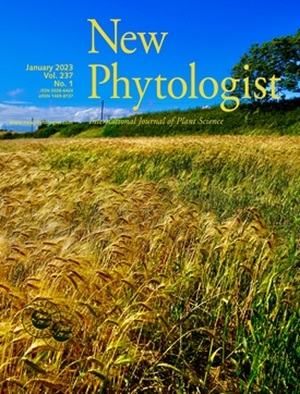左右不对称通过器官之间的物理相互作用导致水稻叶片扭曲
IF 8.3
1区 生物学
Q1 PLANT SCIENCES
引用次数: 0
摘要
植物器官的形状受到同一植物内其他器官的限制,但这些限制仍未被报道。在禾草中,新叶通常在老叶形成的空间内发育,这对发育中的叶片施加了空间限制。本研究的重点是水稻(Oryza sativa)突变体DSK115,它表现出扭曲的叶片,以了解约束如何影响叶片发育。我们通过微X射线计算机断层扫描(micro - CT)量化了在由老叶鞘形成的圆柱形空间内发育的扭曲和非扭曲叶片的三维形状。我们还使用计算模型来确定叶片表型。CT扫描显示叶片内外缘因叶宽左右不对称而发生物理接触,叶鞘内空间缩小导致叶片生长受到物理抑制。模拟模型表明,这些因素可以产生像DSK115这样的扭曲结构。研究表明,叶片的扭曲符合叶片内外边缘的物理接触和叶片生长的物理抑制的机械解释。本文章由计算机程序翻译,如有差异,请以英文原文为准。
Left–right asymmetry causes twisting in rice (Oryza sativa) leaves via physical interaction between organs
Summary Shape of plant organs is constrained by other organs within the same plant, yet these constraints remain under‐reported. In grasses, new leaves typically develop inside the space formed by the older leaf, which imposes spatial restrictions on the developing leaf. This study focused on the rice (Oryza sativa ) mutant, DSK115, which exhibits twisted leaf blades to understand how constraints affect leaf development. We quantified 3D shapes of twisted and nontwisted leaves developing inside the cylindrical space formed by the older leaf sheath by micro X‐ray computed tomography (micro‐CT). We also used computational modelling for qualifying leaf phenotype. CT scanning showed physical contact between the inner and outer edges of a leaf blade due to left–right asymmetry in leaf width, and physical inhibition of leaf growth due to reduced space within the enclosing leaf sheath. The simulation models demonstrated these factors could produce a twisted structure like DSK115. The study revealed the twisting of leaf blades is consistent with a mechanical explanation by physical contact between the inner and outer edges of a leaf blade and physical inhibition of leaf growth.
求助全文
通过发布文献求助,成功后即可免费获取论文全文。
去求助
来源期刊

New Phytologist
生物-植物科学
自引率
5.30%
发文量
728
期刊介绍:
New Phytologist is an international electronic journal published 24 times a year. It is owned by the New Phytologist Foundation, a non-profit-making charitable organization dedicated to promoting plant science. The journal publishes excellent, novel, rigorous, and timely research and scholarship in plant science and its applications. The articles cover topics in five sections: Physiology & Development, Environment, Interaction, Evolution, and Transformative Plant Biotechnology. These sections encompass intracellular processes, global environmental change, and encourage cross-disciplinary approaches. The journal recognizes the use of techniques from molecular and cell biology, functional genomics, modeling, and system-based approaches in plant science. Abstracting and Indexing Information for New Phytologist includes Academic Search, AgBiotech News & Information, Agroforestry Abstracts, Biochemistry & Biophysics Citation Index, Botanical Pesticides, CAB Abstracts®, Environment Index, Global Health, and Plant Breeding Abstracts, and others.
 求助内容:
求助内容: 应助结果提醒方式:
应助结果提醒方式:


